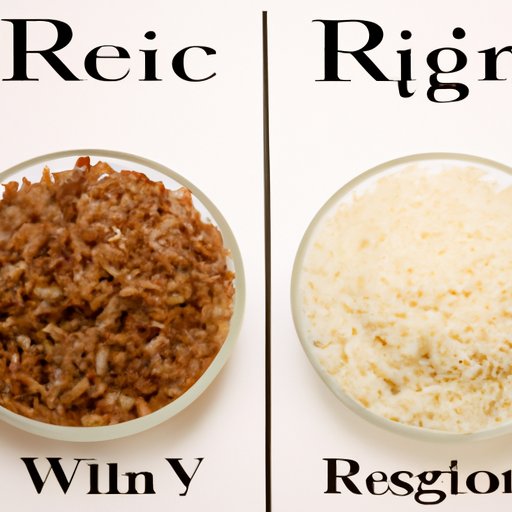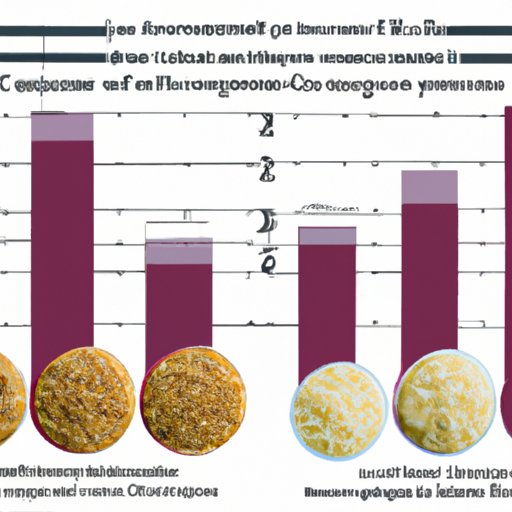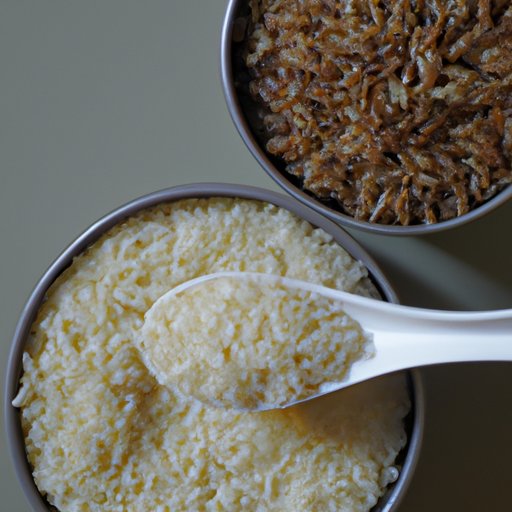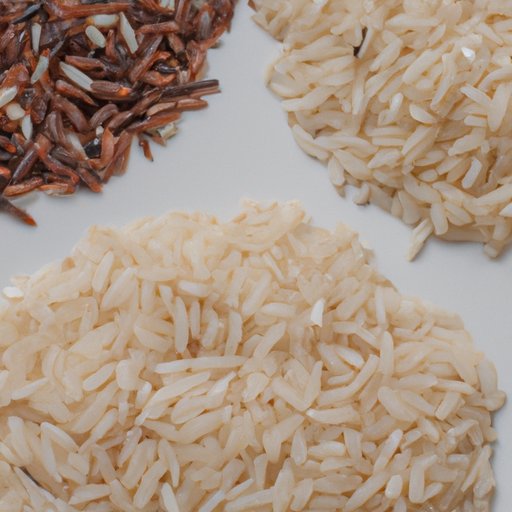Introduction
Rice is a staple food in many countries around the world, including the United States. It is a versatile grain that can be prepared in a variety of ways, making it an ideal ingredient for countless dishes. While there are many types of rice to choose from, two of the most popular varieties are brown rice and white rice. But which one is healthier? Many people wonder if brown rice is really better for them than white rice. In this article, we will explore the nutritional differences between the two and examine the potential health benefits of eating brown rice over white rice.
Comparing the Nutritional Differences between Brown and White Rice
When it comes to the nutritional content of brown and white rice, there are a few key differences to consider. Let’s start by looking at the macronutrients:
Brown rice contains more calories and carbohydrates than white rice, with one cup of cooked brown rice providing 108 calories and 23 grams of carbohydrates. On the other hand, one cup of cooked white rice provides only 88 calories and 20 grams of carbohydrates. Brown rice also has more protein than white rice, with 2.6 grams per cup compared to 1.8 grams per cup of white rice. Both types of rice contain very little fat.
Now let’s look at the micronutrients:
Brown rice is a good source of several essential vitamins and minerals, including manganese, selenium, phosphorus, magnesium, and niacin. It is also higher in dietary fiber than white rice, with 3.5 grams per cup compared to 0.6 grams per cup of white rice. White rice is higher in iron, however, with 0.9 milligrams per cup compared to just 0.4 milligrams per cup of brown rice.

Examining the Health Benefits of Eating Brown Rice over White Rice
There are several potential health benefits associated with eating brown rice instead of white rice. For starters, brown rice is higher in antioxidants, which can help protect against cell damage caused by free radicals. According to a 2012 study published in the Journal of Food Science, brown rice contains significantly higher amounts of phenolic compounds, flavonoids, and antioxidant activity than white rice.
In addition, studies have shown that brown rice may help reduce the risk of cardiovascular disease. One 2008 study published in the American Journal of Clinical Nutrition found that replacing white rice with brown rice was associated with a lower risk of coronary heart disease.
Finally, brown rice may help maintain healthy blood sugar levels. A 2014 study published in the journal Diabetes Care found that eating brown rice as part of a low-glycemic index diet improved glycemic control and reduced fasting insulin levels in participants with type 2 diabetes.

Exploring the Impact of Processing on the Nutritional Value of Brown and White Rice
It is important to note that the nutritional differences between brown and white rice are largely due to the processing methods used. Brown rice is simply the whole grain form of white rice, meaning that it has not been processed or polished. As a result, it retains its bran layer and germ, which is where most of the nutrients are found. The bran layer and germ are removed during the milling process for white rice, resulting in a much lower nutrient content.
The milling process also strips away some of the beneficial phytochemicals, such as polyphenols and phytic acid, which are present in brown rice but not in white rice. Additionally, the refining process removes some of the fiber from white rice, further reducing its nutritional value.

Investigating How Substituting Brown Rice for White Rice Can Improve Overall Health
Substituting brown rice for white rice can have a number of positive effects on overall health. For example, eating brown rice instead of white rice may help with weight management. A 2020 study published in the journal BMC Nutrition found that replacing white rice with brown rice was associated with a lower body mass index (BMI) and waist circumference.
Eating brown rice may also help improve digestion. Brown rice is higher in dietary fiber than white rice, which helps promote healthy digestion by adding bulk to your stool and increasing the speed at which food moves through your digestive tract.
Discussing the Cost-Effectiveness of Switching to Brown Rice
Many people may be hesitant to switch to brown rice due to cost concerns. However, in many cases, brown rice can actually be more cost-effective than white rice. To compare prices, you must take into account the difference in serving sizes. A cup of cooked brown rice typically yields twice as much as a cup of cooked white rice, so the price per serving should be taken into account when making a decision.
Another factor to consider is nutrient-density. Brown rice is generally more nutrient-dense than white rice, meaning that you get more nutrition for your money. This makes it a more cost-effective choice in the long run.
Analyzing the Role of Dietary Fiber in Brown Rice Versus White Rice
Dietary fiber is an important part of any balanced diet, and it is especially important for those who are trying to lose weight or maintain a healthy weight. Brown rice is higher in dietary fiber than white rice, with 3.5 grams per cup compared to 0.6 grams per cup. Dietary fiber is divided into two categories: soluble and insoluble. Brown rice is higher in both types of fiber, with 2.1 grams of soluble fiber and 1.4 grams of insoluble fiber per cup.
Soluble fiber is thought to help reduce cholesterol levels and stabilize blood sugar levels, while insoluble fiber helps add bulk to your stool and promotes regular bowel movements. Both types of fiber play an important role in maintaining a healthy digestive system.
Conclusion
In summary, brown rice is generally considered to be healthier than white rice due to its higher nutrient content and potential health benefits. Brown rice is higher in calories, carbohydrates, protein, and dietary fiber than white rice, and it also contains more antioxidants, vitamins, and minerals. Eating brown rice may help reduce the risk of cardiovascular disease, maintain healthy blood sugar levels, and promote weight management. Additionally, brown rice is often more cost-effective than white rice and provides more nutrition for your money.
While brown rice is generally considered to be healthier than white rice, it is important to remember that both types of rice can be part of a healthy diet. The key is moderation and variety. Try incorporating different types of grains into your meals and snacks to ensure that you are getting a wide range of nutrients.
(Note: Is this article not meeting your expectations? Do you have knowledge or insights to share? Unlock new opportunities and expand your reach by joining our authors team. Click Registration to join us and share your expertise with our readers.)
